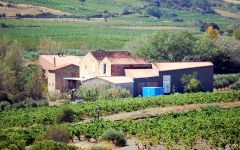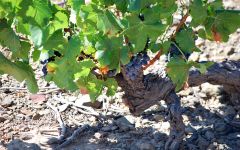Chateau Saint-Roch Cotes du Roussillon Kerbuccio 2011
-
Robert
Parker


Product Details
Your Rating
Somm Note
Winemaker Notes
Blend: Grenache 40%, Syrah 40% Mouvedre 20%
Professional Ratings
-
Robert Parker's Wine Advocate
The backside of this region is Corbieres, but this opaque purple-colored 2011 Kerbuccio would blow away just about any Corbieres. A wine of great intensity, it offers up copious floral, blackberry and blueberry fruit intermixed with hints of charcoal, scorched earth and wet rocks. Dense and full-bodied with tremendous richness and supple tannins...







Recently purchased by Jean Marc Lafage, Chateau Saint Roch is located in the Maury Area of the Agly Valley, which is 15 miles from Perpignan and the Mediterranean Sea. The castle of Queribus, built by the Cantharis, at the top of the steep Corbières Mountain watches over the vineyards from the north. Each plot is now surrounded by black berry bushes, fig trees, pomegranate trees, cherry trees, carob trees, oaks, as well as fields of thyme, lavender and fennel.
The soil of the hills is made up of schiste clay with a limestone base and their altitudes vary between 120 to 370 meters. The wind, called here the "Tramontane", circulates in this corridor between Fenouillèdes and Corbières. The southern Catalan sun takes advantage of the refractive qualities of the schist from this ancient icy plateau to give St Roch its unique light.

With hundreds of red grape varieties to choose from, winemakers have the freedom to create a virtually endless assortment of blended red wines. In many European regions, strict laws are in place determining the set of varieties that may be used, but in the New World, experimentation is permitted and encouraged resulting in a wide variety of red wine styles. Blending can be utilized to enhance balance or create complexity, lending different layers of flavors and aromas. For example, a red wine blend variety that creates a fruity and full-bodied wine would do well combined with one that is naturally high in acidity and tannins. Sometimes small amounts of a particular variety are added to boost color or aromatics. Blending can take place before or after fermentation, with the latter, more popular option giving more control to the winemaker over the final qualities of the wine.
How to Serve Red Wine
A common piece of advice is to serve red wine at “room temperature,” but this suggestion is imprecise. After all, room temperature in January is likely to be quite different than in August, even considering the possible effect of central heating and air conditioning systems. The proper temperature to aim for is 55° F to 60° F for lighter-bodied reds and 60° F to 65° F for fuller-bodied wines.
How Long Does Red Wine Last?
Once opened and re-corked, a bottle stored in a cool, dark environment (like your fridge) will stay fresh and nicely drinkable for a day or two. There are products available that can extend that period by a couple of days. As for unopened bottles, optimal storage means keeping them on their sides in a moderately humid environment at about 57° F. Red wines stored in this manner will stay good – and possibly improve – for anywhere from one year to multiple decades. Assessing how long to hold on to a bottle is a complicated science. If you are planning long-term storage of your reds, seek the advice of a wine professional.

Although it is a region predominantly recognized for fortified, vins doux naturels (a type of sweet wine), Roussillon is also ideal for the production of dry red, white and rose wines. To encompass all the dry wines from the surrounding region that are not the vins doux naturels of Banyuls, Maury and Rivesaltes, the appellation of Côtes du Roussillon was created in 1977. It covers the eastern half of the Pyrénées-Orientales (the eastern side of the Pyrenees Mountains) and lower lands of Roussillon. Côtes du Roussillon includes complex soils of schist, limestone, gneiss and granite and climatic conditions that support many grape varieties.
Côtes du Roussillon red wines are blends made from Grenache, Syrah, Mourvedre and smaller amounts of Carignan, Cinsault and the lesser known, Lledoner Pelut. Rosé wines come from the same varieties, as well as may include Grenache Gris and Macabeo. White wines from Côtes du Roussillon are Grenache Blanc and Macabeo with small amounts of Marsanne, Roussanne and Rolle (aka Vermentino).
